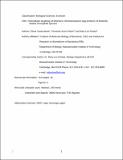| dc.contributor.author | Pardue, Mary-Lou | |
| dc.contributor.author | Casacuberta, Elena | |
| dc.contributor.author | Marin, Fernando Azorin | |
| dc.date.accessioned | 2013-01-10T17:41:26Z | |
| dc.date.available | 2013-01-10T17:41:26Z | |
| dc.date.issued | 2007-03 | |
| dc.date.submitted | 2007-02 | |
| dc.identifier.issn | 0027-8424 | |
| dc.identifier.issn | 1091-6490 | |
| dc.identifier.uri | http://hdl.handle.net/1721.1/76237 | |
| dc.description.abstract | The retrotransposons that maintain telomeres in Drosophila melanogaster have unique features that are shared across all Drosophila species but are not found in other retrotransposons. Comparative analysis of these features provides insight into their importance for telomere maintenance in Drosophila. Gag proteins encoded by HeT-A[superscript mel] and TART[superscript mel] are efficiently and cooperatively targeted to telomeres in interphase nuclei, a behavior that may facilitate telomere-specific transposition. Drosophila virilis, separated from D. melanogaster by 60 MY, has telomeres maintained by HeT-A[superscript vir] and TART[superscript vir]. The Gag proteins from HeT-A[superscript mel] and HeT-A[superscript vir] have only 16% amino acid identity, yet several of their functional features are conserved. Using transient transfection of cultured cells from both species, we show that the telomere association of HeT-A[superscript vir] Gag is indistinguishable from that of HeT-A[superscript mel] Gag. Deletion derivatives show that organization of localization signals within the two proteins is strikingly similar. Gag proteins of TART[superscript mel] and TART[superscript vir] are only 13% identical. In contrast to HeT-A, surprisingly, TART[superscript vir] Gag does not localize to the nucleus, although TART[superscript vir] is a major component of D. virilis telomeres, and localization signals in the protein have much the same organization as in TART[superscript mel] Gag. Thus, the mechanism of telomere targeting of TART[superscript vir] differs, at least in a minor way, from that of TART[superscript mel]. Our findings suggest that, despite dramatic rates of protein evolution, protein and cellular determinants that correctly localize these Gag proteins have been conserved throughout the 60 MY separating these species. | en_US |
| dc.description.sponsorship | National Institutes of Health (U.S.) (Grant GM50315) | en_US |
| dc.language.iso | en_US | |
| dc.publisher | National Academy of Sciences | en_US |
| dc.relation.isversionof | http://dx.doi.org/10.1073/pnas.0702566104 | en_US |
| dc.rights | Article is made available in accordance with the publisher's policy and may be subject to US copyright law. Please refer to the publisher's site for terms of use. | en_US |
| dc.source | Pardue via Courtney Crummett | en_US |
| dc.title | Intracellular targeting of telomeric retrotransposon Gag proteins of distantly related Drosophila species | en_US |
| dc.type | Article | en_US |
| dc.identifier.citation | Casacuberta, E., F. A. Marin, and M.-L. Pardue. “Intracellular Targeting of Telomeric Retrotransposon Gag Proteins of Distantly Related Drosophila Species.” Proceedings of the National Academy of Sciences 104.20 (2007): 8391–8396. | en_US |
| dc.contributor.department | Massachusetts Institute of Technology. Department of Biology | en_US |
| dc.contributor.approver | Pardue, Mary-Lou | |
| dc.contributor.mitauthor | Pardue, Mary-Lou | |
| dc.relation.journal | Proceedings of the National Academy of Sciences | en_US |
| dc.eprint.version | Author's final manuscript | en_US |
| dc.type.uri | http://purl.org/eprint/type/JournalArticle | en_US |
| eprint.status | http://purl.org/eprint/status/PeerReviewed | en_US |
| dspace.orderedauthors | Casacuberta, E.; Marin, F. A.; Pardue, M.-L. | en |
| dc.identifier.orcid | https://orcid.org/0000-0002-4448-0785 | |
| mit.license | PUBLISHER_POLICY | en_US |
| mit.metadata.status | Complete | |
